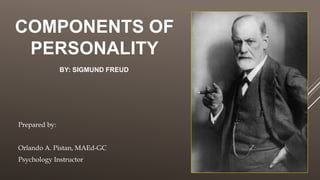Components of Personality- Freud
•Transferir como PPTX, PDF•
1 gostou•1,746 visualizações
Lesson in Understanding the Self and Theories of Personality
Denunciar
Compartilhar
Denunciar
Compartilhar

Recomendados
Mais conteúdo relacionado
Mais procurados
Mais procurados (20)
Sigmund freud- psychoanalysis and psychosexual theory

Sigmund freud- psychoanalysis and psychosexual theory
UTS.THE-PSYCHOLOGICAL-PERSPECTIVE-OF-THE-SELF.pptx

UTS.THE-PSYCHOLOGICAL-PERSPECTIVE-OF-THE-SELF.pptx
Semelhante a Components of Personality- Freud
Semelhante a Components of Personality- Freud (20)
Pychodynamic personality theory its contributions and limitations

Pychodynamic personality theory its contributions and limitations
Psychodynamic Model/Approach. By Theresa Lowry-Lehnen. Lecturer of Psychology

Psychodynamic Model/Approach. By Theresa Lowry-Lehnen. Lecturer of Psychology
Mais de Orlando Pistan, MAEd
Mais de Orlando Pistan, MAEd (20)
Último
Último (20)
Basic Civil Engineering first year Notes- Chapter 4 Building.pptx

Basic Civil Engineering first year Notes- Chapter 4 Building.pptx
Unit-IV; Professional Sales Representative (PSR).pptx

Unit-IV; Professional Sales Representative (PSR).pptx
Beyond the EU: DORA and NIS 2 Directive's Global Impact

Beyond the EU: DORA and NIS 2 Directive's Global Impact
Z Score,T Score, Percential Rank and Box Plot Graph

Z Score,T Score, Percential Rank and Box Plot Graph
Ecological Succession. ( ECOSYSTEM, B. Pharmacy, 1st Year, Sem-II, Environmen...

Ecological Succession. ( ECOSYSTEM, B. Pharmacy, 1st Year, Sem-II, Environmen...
ICT Role in 21st Century Education & its Challenges.pptx

ICT Role in 21st Century Education & its Challenges.pptx
SECOND SEMESTER TOPIC COVERAGE SY 2023-2024 Trends, Networks, and Critical Th...

SECOND SEMESTER TOPIC COVERAGE SY 2023-2024 Trends, Networks, and Critical Th...
Components of Personality- Freud
- 1. COMPONENTS OF PERSONALITY Prepared by: Orlando A. Pistan, MAEd-GC Psychology Instructor BY: SIGMUND FREUD
- 2. HUMAN INSTINCTS Freud believed that all human behavior is energized by psychodynamic forces. Presumably, each individual has a fixed amount of psychic (or mental) energy that he uses to think, to learn, and to perform other mental functions. Eros Thanatos
- 3. EROS Also known as “life instinct”. It directs life-sustaining activities such as respiration, eating, sex, and the fulfillment of all bodily needs.
- 4. THANATOS Also known as “death instinct”. A set of destructive forces present in all human beings. Freud believe that eros is stronger than thanatos. He further argued that when thanatos reach its critical point, it is shown in some way. Arson, fights, war, murder and even masochism is an expression of thanatos.
- 5. COMPONENTS OF PERSONALITY There are 3 components of personality according to Sigmund Freud: Id Ego Superego
- 6. THE ID o The Id is present at birth. o The Biological component of personality. o It includes our instincts, needs and wants. o Always selfish and needy. o Operates according to the Pleasure principle.
- 7. PLEASURE PRINCIPLE The idea that all of our needs and wants should be met immediately.
- 11. THE SUPEREGO o It develops as an individual learns what their culture considers right and wrong. o Always concern with what is socially acceptable. o Pushes us to obtain the Ego ideal – your view of what is right. o It represents our Conscience.
- 12. CONSCIENCE Our view of what is considered wrong.
- 15. THE EGO o The rational and pragmatic component of personality. o Known as the “self”. o The decision-maker o Faces consequences. o Operates in the Reality principle.
- 16. REALITY PRINCIPLE The idea that the desires of the Id must be satisfied in a method that is both socially appropriate and realistic.
- 17. COMPREHENSION CHECK-UP: 1. What are the 3 components of personality according to Sigmund Freud? 2. The Id operates in _____ principle. 3. The component of personality which is known as the “self” is the _____. 4. The personality component which represents our conscience is the _____. 5. _____ operates in the reality principle.
- 18. SUMMARY
- 19. Id “ I want to do that now ” Superego “ It is not right to do that ” Ego “ Maybe we can compromise ” According to Freud, our personality is always facing the conflict of the 3 components. The job of the Ego is to balance the aggressive, pleasure- seeking drives of the Id with the moral control of the Superego.
- 21. COMPONENTS OF PERSONALITY Thank you for paying attention. BY: SIGMUND FREUD
